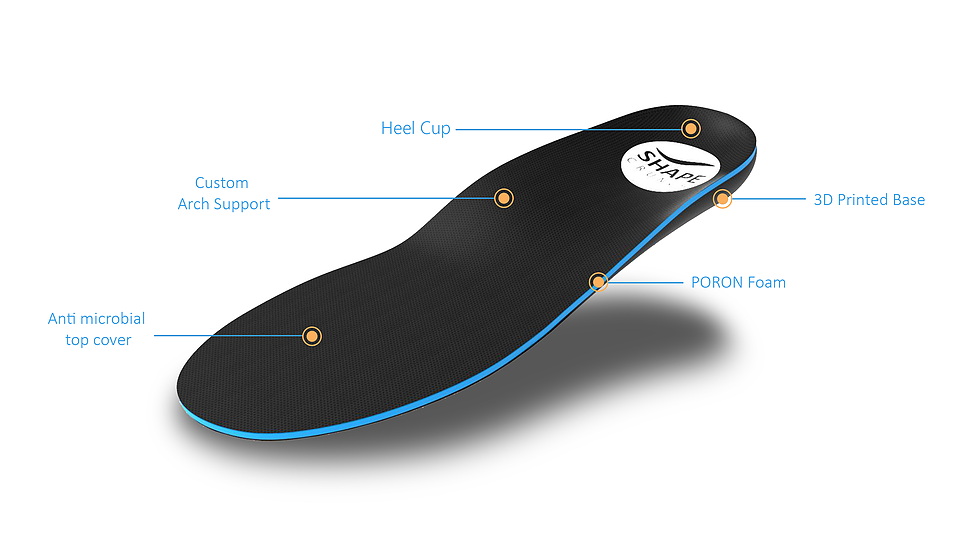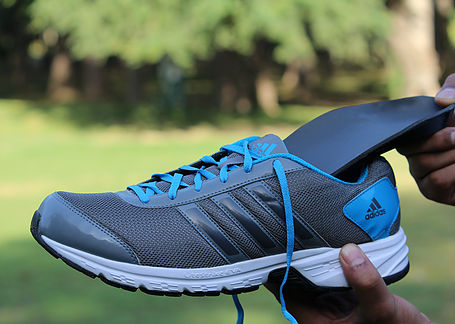nalco group
bone, muscle & joint pain physio
BOOK NOW / WHATSAPP ABOUT YOUR PAIN OR INJURY
- ORCHARD 400 Orchard Road #12-12 Singapore 238875
- TAMPINES 9 Tampines Grande #01-20 Singapore 528735
- SERANGOON 265 Serangoon Central Drive #04-269 Singapore 550265
Home > Customized Insoles (Shapecrunch) > Customized Insoles Stress Fracture Treatment
Customized Insoles Stress Fracture Treatment
What Is Stress Fracture?
A small crack in a bone or severe bruising within a bone is called as Stress Fracture.
The main reasons behind stress fractures are overuse and repetitive activity; and therefore they are more common in runners and athletes as they participate in running sports, such as soccer and basketball.
People are more prone to stress fractures when they change their activities- such as by suddenly increasing the intensity of their workouts or by trying a new exercise, or changing the workout surface (for example: jogging on a treadmill to jogging outdoors).
In addition, if the bones are already weak because of problems like osteoporosis or other diseases, just doing everyday activities may lead to stress fracture.
The most vulnerable parts of the body to stress fracture are the weight-bearing bones of the foot and a lower leg because of the repetitive forces they must absorb during activities like walking, running, and jumping.
Most common locations for stress fractures are following:
- calcaneus (heel bone),
- femoral neck in the hip,
- femur (thigh bone),
- fibula,
- metatarsal bones of the foot,
- navicular bone in the foot,
- pars articularis of the lumbar spine.
- pubic rami of the pelvis,
- sacrum, and
- tibia (shin bone)
How Stress Fracture Develops?
Most stress fractures are the injuries that are the result of overuse. They occur over time when tedious forces result in microscopic impairment to the bone.
The kind of repetitive force that causes a stress fracture is not prodigious enough to cause an acute fracture. When an athletic movement is repeated very often, overuse stress fractures occur because the weight-bearing bones and supporting muscles do not get enough time to heal between exercise sessions.
Bone is in a constantly under a process called remodeling. Bone remodeling is bone metabolism. This is a lifelong process in which the mature bone tissue is removed from the skeleton and new bone tissue is formed.
If an athlete's activity is creating a lot of impacts, the rate of breakdown of older bone outstrips the rate of formation of the new ones. Hence it beats the body's ability to repair and replace it. Consequently, the bone weakens and becomes susceptible to stress fractures.
What Are The Indications Of Stress Fracture?
- Weakness in a limb or a foot or the ankle, with or without pain. A runner may suddenly find himself incapable of matching the previous speeds or distance without feeling exhausted or having a leg collapse. Though some people might not experience any pain at all, absinthe nice of pain is highly unlikely.
- A dull pain that comes and goes with repetitive activity or weight-bearing. For example, pain in the foot or ankle that is very evident when the foot hits the ground while running or dancing, but disappears once the exercise sessions cease, or pain in the shoulder or elbow that may occur during the activities like throwing or receiving a ball. It’s not necessary that the pain will start at the beginning of the exercise; it may even develop eventually at some point during the activity.
- A dominant pain that gets localized especially at night. Pain in a certain area, such as the foot, hip, or ankle that occurs in the evening is often allied with stress fractures, even if the pain is not incapacitating during sports activities.
- Distressing, sore pain that you can feel deep within the foot, toe, hip, ankle, shin, or arm. It may be difficult to pinpoint the exact source of the pain, such as a general throbbing in the entire foot or lower leg.
- Pain in the back or sides. Badgering pain in the trunk can sometimes be an indicator of stress fractures in the rib cage and/or sternum. This type of pain occurs most commonly in athletes who participate in sports such as rowing, tennis, or baseball.
- Pain that does not improve with rest, ice, compression, and elevation; or a pain that subdues after rest, ice, compression, and elevation but resumes or remains constant in a while.
- Tenderness and swelling in the affected area. The soft tissue around a stress fracture is often tender and swollen to the touch. In some severe cases, bruising may also be present. Although this is very rare.
What Are The Causes Of Stress Fracture?
-
Insufficiency
of bones
Conditions that decrease bone strength or its density (diseases like osteoporosis or taking certain long-term medications) makes your body more prone to a stress fracture even when you are performing normal day-to-day activities.
For example, during the winter, when Vitamin D is lower in the body, the body is more prone to stress fractures.
-
Surface
Change
A change in playing surface or the type of training can increase the risk of stress fracture. For example, if a tennis player goes from a grass court to a hard court, or a runner moving from a treadmill machine to running outside.
-
Gender
Studies show that female athletes are more prone to stress fractures than male athletes. This may be due, in part, to decreased bone density from a condition that doctors call the "female athlete triad."
Three interrelated illnesses develop when a girl or young woman goes to extremes in dieting or exercise, that are: eating disorders, premature osteoporosis, and menstrual dysfunction. As a result, the female athlete's bone mass decreases and consequently her chances for getting a stress fracture increase.
-
Unsuitable
Equipment
Wearing worn-out or ill-fitted shoes that have lost or do not have shock-absorbing ability may lead to stress fracture.
-
Inappropriate
Technique
Any equipment or process that may alter the mechanics of how your foot’s impact absorption when it hits the ground may increase your chances of encountering a stress fracture.
For example, if you have a blister, it is very important that you take proper care of how you put weight on your foot when you walk or run. You may require an area of bone to support and handle more weight and pressure than usual.
-
Poor
Conditioning
Doing a lot of physical strenuous activities in a short interval of time is a common cause of stress fracture. Although this is very common in the case with individuals who are just beginning an exercise program it can also occur, inexperienced athletes, as they sometimes over-do.
For example, athletes who train less over the period of winter may desperately try to pick up right where they left off at the end of the previous season. Instead of starting off slowly, they resume running at their previous mileage.
This situation in which athletes not only increase activity levels but push through any discomfort and do not give their bodies the opportunity to recover can lead to stress fractures.
-
Repetitive
actions
The most common cause of stress fractures is a sudden increase in physical activity. This increment can be in the repetition of the activity (like exercising more number of days per week). It can also be in the intensity or duration of activity (like, running longer distances).
Even for the non-athlete, a sudden increase in activity can cause a stress fracture. For example, if you are not a frequent walker and start walking excessively due to various reasons, you might experience a stress fracture. Your foot's ability to absorb repetitive forces can be lessened up by adopting a new style of shoes and ultimately result in a stress fracture.
Stress Fracture Treatments
PREVENTION
customized insoles


How Insoles Helps With Stress Fracture
Orthotics 3D custom insoles have a very supportive built-in arch and also have an additional pads offer better metatarsal protection as they are added under the cover in order to increase the arch height.
The best way to prevent the return of the stress fractures is by having arch support most of time. These orthotics are available in a variety of preparations and can be constructed from many different materials depending on their function and the desired rigidity or support.
The 3D custom insoles lower stress fracture incidence by improving foot biomechanics, lessening fatigue of the lower extremities, and attenuating impact.
When an orthotic is placed inside the shoe, the goal of the device is to help stabilize the skeletal structure within the foot, and properly position the bones within the foot so they can function at their full extent. This will help to take stresses off the muscles, tendons and ligaments.
It will also reduce some of the stress on the bones.
Orthotics 3D Custom Technology And It's Design
Orthotics 3D Custom Insoles support all 3 arches of the foot, which make up the plantar vault and metatarsal bone set.
They’re custom-made by hand, based on your unique feet, body, and health profile. Everybody is different and hence every pair of feet are different.
The 3D custom insoles thus designed are also different from each other. Over-the-counter orthotics may cost less, but they do not support all the arches in your foot. Supporting only one of the arches will not maintain the structure of your feet need to provide to support your bodyweight.
This will in fact lead to problems in other parts of your body. This implies that over-supporting only one of the arches of the foot, instead of relieve them, will actually cause pain.
Benefits
- The foot orthotics 3D custom insoles have a personalized profile and are used for the optimization of foot function. These inserts can help manage the weight distribution and pressure as the foot hits the ground. They alter muscle activity and running mechanics and hence exponentially reduce the chance of a stress fracture. They help in shielding the bone by redistributing the force going through the bones.
- One of the most important usages of custom insoles includes reduction of the force of impact when the foot hits the ground, thus potentially evading the damage to muscles, tendons, and bones.
- These supportive insoles are the best way to align and stabilize the foot and ankle area.
Customized Insoles (Shapecrunch) 3D Printed Custom Orthotics
|
|
|
|
Revolutionary custom orthotics 3D printed orthotic insoles to fit your feet perfectly to relieve foot and joint pain and prevent future biomechanical issues. Enjoy excellent arch support, cushioning, and breathability from your custom made shoe inserts.
Feel
like you are walking on air with Shapecrunch Orthotics' innovative
custom 3D printed orthotic insoles - they're fully customized to suit your
individual foot pronation and biomechanic needs and very comfortable to wear.
Everyone's feet are unique, so custom orthotics is the best way to
treat your own individual foot problems and prevent them from
recurring.
Say goodbye to foot pain and hello to comfort
with these custom flat feet insoles today.
Price: SGD 230
By appointment only - contact us for enquiries and appointments
- Email your preferred physiotherapy appointment slot to contact@nalcogroup.com or
- SMS your name, preferred date, time and clinic location to +6588001830 (Novena).
- Clinic locations: see how to get to us here

